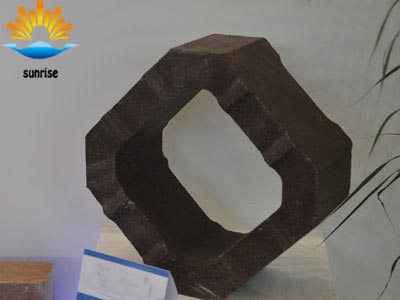Hot Product
Refractory Knowledge
Brief Analysis of Production Process and Advantages of Casting Magnesia Chrome Brick
Date:2019-09-29 16:56 From:Zhengzhou Sunrise Refractory Author:admin
Conventional fired refractories, a certain amount of micropores and microcracks exist between the refractories. These micropores and microcracks can absorb and alleviate some of the thermal stress at high temperatures, but at the same time bring some disadvantages, that is, they are very susceptible. Infiltration of smelting slag. Compared with the steel industry, non-ferrous smelting has a relatively low smelting temperature, but a large amount of slag. The slag is a highly corrosive ferrite or silicate. The slag has low viscosity and small interfacial tension. Infiltration and permeability. Therefore, after the fired refractory material is used in the non-ferrous smelting furnace, the permeation metamorphic layer is relatively thick, and it is prone to structural looseness, strength drop, peeling and the like. The slag infiltration leads to structural spalling, which is the main reason for the high consumption and low life of non-ferrous smelting refractories.
The cast-cast magnesia-chrome brick has unique advantages over the damage mechanism of slag infiltration, because it is a dense frit made by melting, casting, and integral cooling, and the slag can only have a corrosion effect on the surface of the brick. Penetration is unlikely to occur (this has been confirmed by the identification of the cast-molded magnesia-chrome brick after use). Therefore, although the production of magnesia-chromium bricks is difficult and expensive, the key parts of the non-ferrous smelting furnaces in the developed countries still retain the irreplaceable advantages of other refractories.

Oxygen-rich flash smelting and oxygen-rich molten pool smelting are the internationally advanced non-ferrous metal smelting technologies; the common features of these new smelting technologies are oxygen-enriched blasting and intensive smelting, whereby the lining refractory is subjected to very demanding use. Conditions, domestic refractories are still difficult to meet these requirements. While developing and introducing advanced smelting technology, the development of refractory materials used in oxygen-rich smelting technology, especially the smelting of magnesia-chromium bricks, is necessary for the digestion and absorption of imported technologies and the acceleration of localization.
The production process of fused cast magnesia chrome brick is completely different from the conventional sintered refractory production method. It uses magnesium sand and chrome ore to add a certain amount of admixture, mix ingredients, melt in electric arc furnace, cast into the model, and control cooling annealing. Production into mother bricks, after cutting, grinding, drilling, cold processing, to produce the required brick type.
If you are interested in Sunrise Refractory cast magnesite, please send us an email for more details and the latest offer.
Inquiry:
If you have any questions or good suggestions on our products and site, or if you want to know more information about our products, please write them and send to us, a representative will contact you within one business day. We guarantee that your information will not be divulged to the third party.

